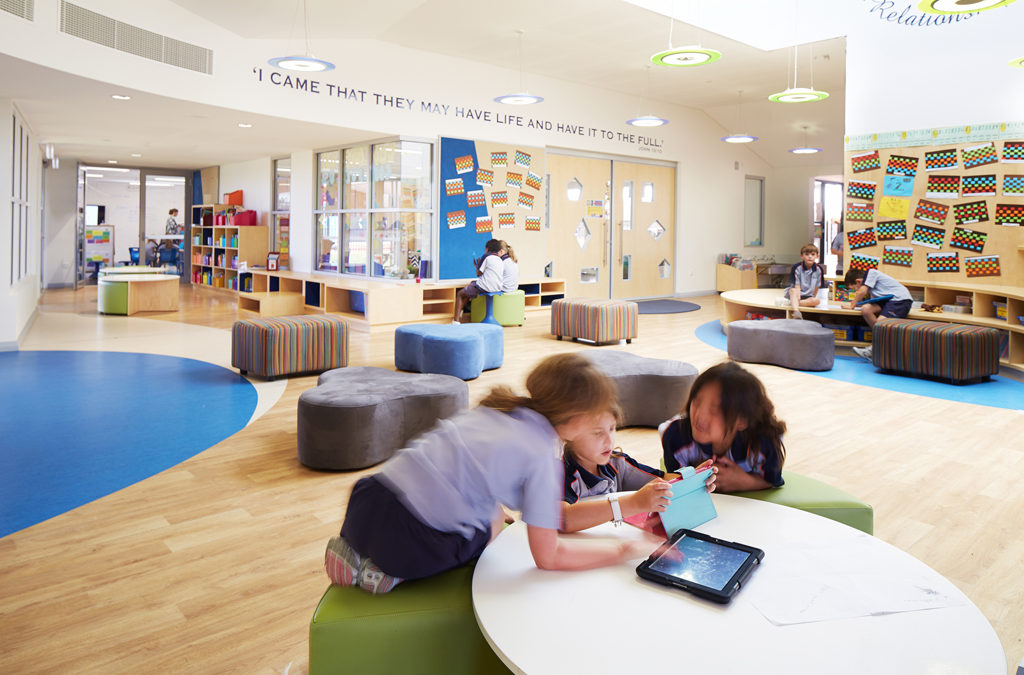No matter where I travel, the people I come in contact with are always talking about pedagogy, educational policy, and the design of learning environments.
These discussions veer to looking at the inside out rather that from the outside in. These views also recognise that the settings need to be crafted to support how people learn and concedes that the physical environment can positively influence the learner along with the learning processes. Regrettably, many of the recent international design solutions for learning environments that are deemed progressive are quite disappointing. While viewed as alternative solutions, these buildings are nothing more than the resurrection of unsuccessful models from years gone by. Generally, it would seem that designers are either unable, disregard, or are unclear of how to transfer ideas about learning into the built form. The reason for this maybe in the questions that are asked:
- How should the learning environments be crafted?
- What are the salient features that can positively impact learning?
- What is the formula?
These questions assume that the physical setting alone can mediate the experiences of the learner. Furthermore, these questions also accept that the most perfect, ideal, and innovative learning environment is determined by the physical qualities of the designed spaces. These questions also presume that the learner will fit the facility.
(As a side note, the facility cannot be planned to fit the learner either. Even with evidence based design for schools, there is no formula. The reason for this is that schools cater to hundreds and thousands of individuals any time. Furthermore, these facilities endure a few generations of learners, since no school is constructed to exist for just twenty years. Lastly, knowing that each learner has specific genetic predispositions that are being shaped and influenced by their experiences and the environments in which they inhabit, the approach should begin with understanding the types of transactions that are intended to occur. Hence, the design brief / educational program must consider what, where, and when the intended activities will take place.)
To contribute thoughtfully to the dialogue on the spatial design of learning environments, and because at the moment with the trend for creating activity based learning environments, i.e. Fab Labs, Maker Spaces along with STEM and STEAM buildings, the questions that need to be asked are:
- What is activity-based learning?
- What is an activity-based learning environment?
- What are the principles for creating activity based learning environments?
Hence, the goal of this series of articles will be to examine and define activity-based learning and provide insight in how to create them.
What is Activity Based Learning?
Activity-based Learning (ABL) is an alternative approach to pedagogy. This approach recognizes that the learner is appropriating knowledge and mastering skills within an active learning environment.
The Learner, the Learning, and Things to be Learned
The roots for this approach may be traced to John Dewey. Dewey’s theory believed in authentic and practical learning experiences (1938, 1959). Authentic activities involve creating simulated situations and real life conditions under which the behaviours/skills are acquired. This approach involves activities that are learner-initiated, routine-based, and planned so that the learner can practice a variety of real-life opportunities to master skills and achieve their educational goals.
Hence, theory and practice are not separate endeavours, but rather occur in relationship to one another, i.e. to understand expansion and contraction in the frame of a truss bridge, design and build one.
Essentially, this pedagogical approach affords the:
- development of goals for the learner that are functional and can be generalized across settings,events, people, and time; implementation of activities to address goals that are learner-directed, routine, and planned;
- learner experiences consequences and timely feedback that are integral to the intervention; and
- learner experiences a variety of learning opportunities to address their goals.
While Dewey examined the learning and the things to be learned, Piaget examined the learner in relationship to their environment. Piaget’s cognitive development theory recognizes that children will actively explore their environment to develop and construct knowledge (Piaget,1970). Piaget’s stages of cognitive development are: sensorimotor (e.g., babies use sensory behaviour for exploration and learning), preoperational (e.g., preschoolers use symbolic but illogical thinking), concrete operational (e.g., school age children use reasoning), and formal operational (e.g., adolescents and adults use abstract reasoning) (Piaget, 1932, 1952, 1967, 1970). Cognitive theory acknowledges the environment as an important consideration in the learning process.
The Learner and the Learning Environment
Through varied experiences with the environment, the learner will put together his understandings of the world in which he lives. Piaget’s theory, however, is limited; for it is dependent on the individual’s choices on an activity and his full engagement in it without consideration of the multiple environmental factors that continually converge on the learner. For this, Urie Bronfenbrenner’s (1979) ecological systems theory will be examined, since his theory takes into account the broad ssocial environment and context which shapes the learner.
The systems are:
- The microsystem is the immediate setting surrounding the child. For example, a child’s family and home is a microsystem.
- The mesosystem is the interactions between two or more microsystems. A child’s visit to the doctor’s office is an example of the mesosystem interacting with other components of the ecological system. The child is influenced by the interaction with the health care provider(s) and health care system, however, the visit to the doctor’s office and the interaction may not immediately impact the child on an ongoing basis.
- The exosystem does not usually include the child in an active role. A parent’s employment is an example of how an external system indirectly influences a child. Other examples that may fit into the exosystem are local government, school board, and church.
- The macrosystem considers the general societal context for the family. The social connections of both the exosystem and macrosystem indirectly influence the child’s development, but the child does not play a direct role. Macrosystem examples may include culture, economic structure, and government.
This theoretical perspective takes into account proximal and distal influences that shape the learner’s development. In addition to the parent/caregiver, the extended family members (e.g., grandparents, cousins, etc.), friends of the family, neighbours, employers, family employment situation, the social community where the person lives (e.g., neighbourhood, town, and region), people in leadership positions who create policies that directly and/or indirectly influence the child’s life, government, culture, social beliefs and norms, and the world community must be considered as influencing the learners behaviour.
Although the ecological systems theory places emphasis on the many layers of the social context that impact human development, an ABL approach must acknowledge the negotiations that occur between the learner and the social environment and the consequences that affect the learner’s development. Building on this, Vygotsky’s sociohistorical theory (1978) is pivotal to understanding how knowledge is appropriated. This viewpoint recognizes that learning is a social process and knowledge acquisition depends on individuals learning from their shared interactions which occur between themselves and their social environment.from the main activity area, when using a break out area, they can be part of the main classroom activity. For example, spaces with glass in walls allow for visual contact between students and teachers. This in turn can allow teachers greater flexibility as they can support independent and small group work to occur in these spaces while providing visual surveillance over the learning activities.
Lastly, Break-Out Spaces can be used by learners as an opportunity for mental and physical restoration. Wachs (1989) discussed the need for children to have access to what is called a “stimulus shelter” a space where a child could escape activity for a brief time to recharge. A Break-Out Space may also afford such needed shelter to young students. If children are able to take advantage of brief period of rest throughout the school day, they may be in a better state to learn and handle conflicts with others.
This article is part 1 of a series published at HoltThink, you can access parts 2-4 here.
References
Barrett. P Zhang, Y. Moffatt, J., & Kobbacy, K. (2012). A holistic, multi-level analysis identifying the impact of classroom design on pupils’ learning. Building and Environment 59 (2013). 678e689. Elsevier Ltd. https://dx.doi.org/10.1016/j.buildenv.2012.09.016.
Bronfenbrenner, U. (1979). The ecology of human development: Experiments by nature and design. Cambridge, MA: Harvard University Press.
Brown, J., Collins, A., & Duguid, P. (1989). Situated cognition and the culture of learning.Educational Researcher, 18(1), 32-42.
Brown, W., & Conroy, M. (1999). Entitled to what? Public policy and the responsibilities of early intervention. Infants & Young Children, 11(3), 27-36.
Dewey, J. (1938). Experience and education. New York: Touchstone.
Dewey, J. (1959). Dewey on education. New York: Teachers College, Columbia University.
Evans, G. W., Kepore, S. J., and Allen, K.M.. (2000). “ Cross cultural differences in tolerance for crowding: Fact or Fiction? Journal of Personality & Social Psychology, pp 204-210.
Greeno, J., Collins, A., & Resnick, L. (1996). Cognition and learning. In D. Berlinger & R.Calfre (Eds.), Handbook of educational psychology (pp. 15-46). New York: MacMillan. 16/07/2015 11  Lave, J. & Wenger. E (1991). Situated Learning Legitimate Peripheral Participation. Cambridge University Press.
Mathews, E. And Lippman, P. C. (2015). Allowing for the Spaces In Between: The Role of Physical Environment in Early Childhood Education. Unpublished.
Lippman, P. C. (2015). The spaces in between. https://pubs.royle.com/publication/?m=31173&l=1.
Lippman, P.C., Randall, R., & Turkes, S. (2014). Thinking outside the box.
Lippman, P. C. (2013). Guiding the Design Process: The Holy Cross College Early Learning Center in Perth (Part II). https://holtthink.tumblr.com/post/81545778780/guiding-the-design-process-the-holy-cross-college.
Lippman P. C. (2010). Evidence Based Design for Elementary and Secondary Schools: A responsive approach to creating learning environments. John Wiley & Sons , NJ.
Lippman, P.C. (1995). The meaning of constructed objects. Unpublished Master’s Thesis. The Graduate Center, The City University of New York: New York.
Piaget, J. (1932). The moral judgment of the child. New York: Free Press.
Piaget, J. (1952). The origins of intelligence in children. New York: International UniversitiesPress.
Piaget, J. (1967). Six psychological studies. New York: Random House.
Piaget, J. (1970). Piaget’s theory. In P. Mussen (Ed.), Carmichael’s manual of child psychology, (Vol. 1, pp. 703-732). New York: Wiley.
PEHKA.(2012) Unpublished Responsive Research Report. Projects for Environmental Health Knowledge and Action, Inc. https://pehka.org/
Putnam, R., & Borko, H. (2000). What do new views of knowledge and thinking have to say about research on teacher learning? Educational Researcher, 29(1), 4-15.
Tharp, R. G. & Gallimore, R. 1997. Rousing Minds to Life: Teaching and Learning in Context. New York: Cambridge University Press.
Valente, D. L., Plevinsky,H. M., Franco, J. M., Heinrichs-Graham, E. C., and Lewis, D. E. (2010). “ Experimental investigation of the effects of the acoustical conditions in a simulated classroom on speech recognition and learning. Annual Meetings of American Auditory Society.
Vygotsky, L. S. (1978). Mind in society: The development of higher psychological processes.Cambridge, MA: Harvard University Press.
Wachs. T. D. (1989). “The nature of the physical microenvironment: An expanded classification system.“ Merill-Palmer Quarterly, pp 163-178.


Recent Comments